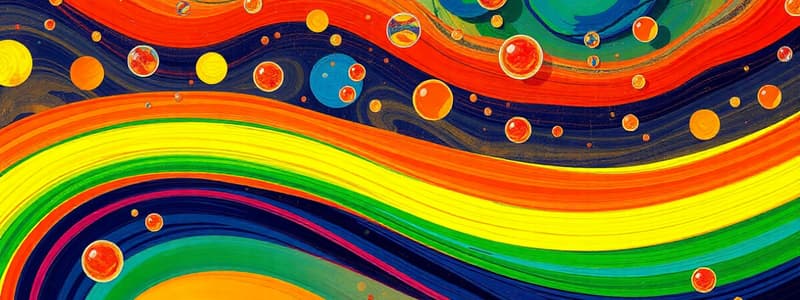Podcast
Questions and Answers
Which of the following best describes the main function of surfactants at interfaces?
Which of the following best describes the main function of surfactants at interfaces?
- To reduce the interfacial tension. (correct)
- To increase the interfacial tension.
- To create a more solid interface.
- To maintain a stable interface.
A molecule with both hydrophilic and hydrophobic portions is essential for surfactant function because it allows the molecule to:
A molecule with both hydrophilic and hydrophobic portions is essential for surfactant function because it allows the molecule to:
- Orient itself at interfaces. (correct)
- Completely ignore all polar or non-polar interactions.
- Dissolve in any solvent.
- Behave as either a strong acid or strong base.
Which category of surfactants is most commonly used in oral and parenteral pharmaceutical dosage forms?
Which category of surfactants is most commonly used in oral and parenteral pharmaceutical dosage forms?
- Anionic surfactants.
- Cationic surfactants.
- Amphoteric surfactants.
- Non-ionic surfactants. (correct)
Which of the following describes the relationship between contact angle and wetting?
Which of the following describes the relationship between contact angle and wetting?
Tweens and Spans are two types of surfactants, what is the main chemical difference between them?
Tweens and Spans are two types of surfactants, what is the main chemical difference between them?
What is the most accurate description of the behavior of wetting agents in terms of contact angle?
What is the most accurate description of the behavior of wetting agents in terms of contact angle?
Which of the following surfactants is an example of a cationic surfactant?
Which of the following surfactants is an example of a cationic surfactant?
What is the main advantage of using the HLB system when formulating with surfactants?
What is the main advantage of using the HLB system when formulating with surfactants?
Flashcards
What is an interface?
What is an interface?
An area where two different phases meet, for example, a liquid and a solid. It can be a surface, but not all surfaces are interfaces.
What are surfactants?
What are surfactants?
Surfactants are molecules that have both a hydrophilic (water-loving) and a hydrophobic (water-hating) part. They reduce interfacial tension by accumulating at the interface.
What are anionic surfactants?
What are anionic surfactants?
Anionic surfactants have a negatively charged head group. Examples include sodium lauryl sulfate (SLS) which is widely used in shampoos and detergents.
What are non-ionic surfactants?
What are non-ionic surfactants?
Signup and view all the flashcards
What is the HLB system?
What is the HLB system?
Signup and view all the flashcards
What is the contact angle?
What is the contact angle?
Signup and view all the flashcards
What are wetting agents?
What are wetting agents?
Signup and view all the flashcards
Why is the solid/liquid interface important?
Why is the solid/liquid interface important?
Signup and view all the flashcards
Study Notes
Interfacial Phenomena - Specific Aims
- Interfacial phenomena are relevant to various dosage forms.
- Interfaces exist between different phases (e.g., gas-liquid, liquid-solid).
- A surface is an interface, but not all interfaces are surfaces (e.g., two gases).
- Interfacial and surface tension exist.
- Surfactants reduce interfacial tension by aligning at the interface with their hydrophilic and hydrophobic portions.
- Four main classes of surfactants exist (anionic, cationic, non-ionic, amphoteric).
- Anionic surfactants are used in certain dosage forms and as disinfectants/preservatives.
- Cationic surfactants can be compatible with anionic ones; sodium lauryl sulfate and benzalkonium chloride are examples.
- Tweens and spans are non-ionic surfactants with varying hydrophilic/hydrophobic properties; Tweens are generally used more often.
- Surfactants are commonly used in many pharmaceutical dosage forms, including oral and parenteral administrated forms.
- Amphoteric surfactants are sometimes used in products.
- Wetting of solid particles and liquid interfaces are important to drug delivery; contact angle is critical.
- Wetting agents affect whether a substance will be wet; these agents can improve drug delivery.
- HLB (hydrophilic-lipophilic balance) is a system that categorizes surfactants and predicts their properties.
- HLB values assist with predicting how surfactants will interact with different drug formulations.
- Surfactant HLB values, are often used to predict how different surfactants will be used.
Studying That Suits You
Use AI to generate personalized quizzes and flashcards to suit your learning preferences.




